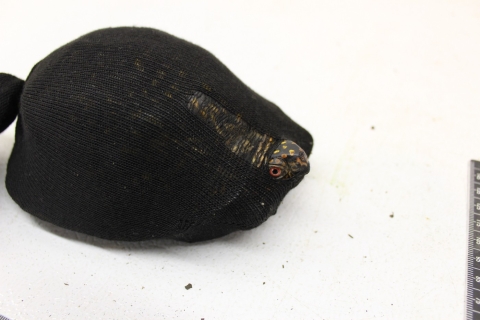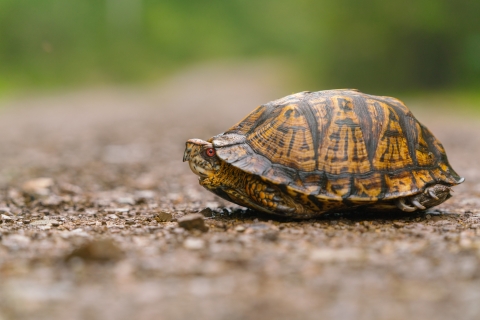By Jennifer Sevin, Kerry Wixted, Lane Kisonak, Bridget Macdonald, Julie Thompson-Slacum, Scott Buchanan and Nancy Karraker
This article was originally published in the November/December 2022 issue of The Wildlife Professional, the magazine of The Wildlife Society.
On a hot August day in 2019, over 200 eastern box turtles (Terrapene carolina) poached from the wild were seized in South Carolina. Crowded and confined to plastic tubs without shelter from the heat, they were dehydrated and malnourished. Several had already died. Investigations later revealed that the smuggler, Nathan Horton, had illegally shipped thousands of North American turtles overseas before he was caught.
Cases like this play out across the country annually, offering a glimpse of what native turtles are up against. On top of habitat loss and car strikes, they face threats from poaching. Whether it’s at the hands of an isolated individual or a sophisticated international smuggling network, the illegal removal of turtles from the wild undermines conservation efforts. Turtles are one of the most imperiled vertebrate groups in the world. More than 60% of species are threatened worldwide, and unsustainable collection is recognized as a primary threat.
Illegal trade has far-reaching consequences for wild turtles. Adults must successfully reproduce multiple times over their long lives to achieve reproductive replacement. Delayed maturation, small clutch sizes, low embryonic and juvenile survival rates, and increased vulnerability for nesting females from road mortality can predispose turtle populations to rapid declines following the substantial loss of adults.
Because adult females are often targeted for illegal trade by breeders, the stakes for population viability are high.
“It’s difficult to determine the exact scale of the problem because it’s illicit,” said Ed Grace, Assistant Director for the U.S. Fish and Wildlife Service’s Office of Law Enforcement. “The gaps in what we know about the scope, breadth and impact of the illegal trade in turtles highlight a need for consistent data gathering and coordination.”
What we do know is that many of our native turtle species are listed as Species of Greatest Conservation Need or as state or federal threatened or endangered — such as box, spotted (Clemmys guttata), wood (Glyptemys insculpta), bog (G. muhlenbergii) and Blanding’s turtles (Emydoidea blandingii) and diamondback terrapins (Malaclemys terrapin) — and are targeted for illegal trade in the U.S. and abroad.
Yik-Hei Sung, assistant professor at Lingnan University in Hong Kong, has been studying the online trade in turtles since 2016. “I regularly see box turtles, diamondback terrapins and spotted turtles sold online in Hong Kong,” he said. “Many appear to have been caught from the wild. With the large numbers of these species being sold and their vulnerability in many U.S. states, I suspect their populations are being impacted by sales overseas.”
In many cases, reptile smuggling co-occurs with other crimes. “International wildlife traffickers operate in sophisticated rings with ties to corruption, fraud and money laundering crimes,” said Ryan Connors, prosecutor with the U.S. Department of Justice.
Illegal trade in turtles is a complex issue. Solving it requires concerted action by stakeholders across supply, transit and demand countries.
A call to action
The Collaborative to Combat the Illegal Trade in Turtles, an interdisciplinary collaboration among agency biologists, law enforcement, legal professionals, academics and nongovernmental organizations, was formed in 2018 in response to a rise in the illegal trade of turtles. Under the Partners in Amphibian and Reptile Conservation umbrella, the group’s members focus on ways to better under-stand, prevent and eliminate the illegal collection and trade of North America’s native turtles.
In 2020, the CCITT, Association of Zoos and Aquariums and Wildlife Trafficking Alliance published “A Call to Action to Protect North America’s Native Turtles from Illegal Collection,” highlighting the need to address this threat to native turtles. The message resonated, garnering support from over 650 conservation professionals and 37 organizations to coordinate and strengthen state regulations, enhance the capacity of wildlife law enforcement, increase resources for housing and caring for confiscated turtles, implement science-based strategies and conduct research and education.
Partnerships and progress are being made, but there is much more work to be done.
Shell games and lawful loopholes
An inconsistent patchwork of state and provincial herpetofaunal regulations complicates matters. According to Andrew Grosse, herpetologist for the South Carolina Department of Natural Resources, it was the Horton case that highlighted South Carolina’s weak regulations and ignited the passage of a bill to end commercial trade in South Carolina’s native turtles and more tightly restrict the take of 13 species.
South Carolina is one of several states that have enhanced its regulations in recent years, recognizing that a state with weaker regulations than its neighbors can welcome traffickers and compromise turtle conservation in surrounding regions. Each jurisdiction maintains its own permitting, take and transport regulations, along with enforcement mechanisms, under an individual statutory framework. The broad variation among these frameworks often confounds regional anti-trafficking efforts.
CCITT has gathered data on the enforcement challenges arising from inconsistent regulations. The Association of Fish and Wildlife Agencies adopted a resolution in favor of making legislative frameworks stronger and more consistent between neighboring states. In addition, AFWA has developed model statutory language in the hope that more states will voluntarily strengthen laws for amphibians and reptiles.
Agency professionals, legislators and executive officials nationwide are mindful of the need to scale up regional coordination of laws and regulations to outmatch the widespread coordination of illegal poachers, buyers and sellers. States such as Florida, Missouri, Texas, Virginia and West Virginia have recently taken steps to limit the collection of wild turtles, with Virginia also expanding protections for herpetofauna with SGCN status.
Wildlife professionals have identified higher fines and penalties, a need for interstate information-sharing, a greater focus on linking turtle-related offenses to non-wildlife offenses, more clarity in regulatory language for licenses and permits, take restrictions for a wider range of species, acquiring restitution funds to care for confiscated turtles and support repatriation efforts, enhancing welfare regulations and enhancing enforcement capacity as essential to strengthening turtle protection.
Supporting the green front line
The investigation and arrest of Nathan Horton required a multi-year commitment and close collaboration between law enforcement from three state wildlife agencies and the USFWS. Building a foolproof case against a turtle trafficker is challenging and time-consuming. It requires dedicated and skilled law enforcement, coupled with the support of management and necessary resources.
“When senior law enforcement are asked to identify their greatest needs, the desire for more officers is mentioned first,” said Mike Ravesi, a wildlife biologist with the Connecticut Department of Energy and Environmental Protection and a CCITT co-chair.
There is no question law enforcement divisions are understaffed, particularly given the large scope of their mission. “Restrictive funding sources and competing demands are other common barriers to law enforcement’s ability to engage on this issue more effectively,” Ravesi said.
Training is also a top priority, with topics ranging from species identification to money laundering. Agencies need skilled personnel, technological resources, regulatory frameworks and training to be able to counter cyber-crime. “The illegal trade in turtles not only involves brick and mortar facilities but is now heavily occurring through social media and other online platforms,” said Florida Fish and Wild-life Conservation Commission Capt. Van Barrow, a co-chair of CCITT’s Law Enforcement Working Group.
Gathering and sharing information in a timely manner are also fundamental needs highlighted by law enforcement. However, there is currently no unified mechanism or framework for collecting data and sharing information across agencies. To help close knowledge gaps, collaborating more broadly with researchers from a variety of disciplines, including natural resources, social sciences, criminal science, policy and economics, is encouraged.
Catching a perpetrator is just one aspect of enforcement. Holding criminals accountable is the responsibility of prosecutors and judges, who may not always fully comprehend the significance of these crimes in terms of damage to wild turtle populations and the loss of ecosystem services they provide, including seed dispersal, nutrient cycling and habitat creation.
“Education to the judicial system is a priority,” said Michelle Christman, PARC’s federal agencies coordinator from the USFWS. “This should no longer be a low-risk, high-reward crime.”
Caring for the confiscated
Once confiscated by law enforcement, turtles face an uncertain future. The capacity to house them, screen them for disease, determine their origin and repatriate them back into the wild is limited. During the 2022 Northeast Illegal Turtle Trade Workshop hosted by CCITT, 80% of 78 poll respondents said they did not have a plan should they need to confiscate 50 or more turtles. Forty percent said it would be a serious challenge to confiscate more than 100. As a result, the CCITT developed a draft confiscation plan template to help develop a process for responding to turtle seizures.
Confiscated turtles are often in poor health from being held in inhumane conditions and require immediate veterinary attention. Animals may also need to be separated and quarantined individually to reduce the risk of spreading disease, such as ranavirus, which recently claimed the lives of 100 eastern box turtles in a single confiscated shipment.
Confiscated turtles are frequently sent to zoos and aquariums, but they often lack adequate space, equipment and funding to provide long-term care. Presently, there is no dedicated facility where confiscated turtles can be sent or funding to provide care and disease testing to facilitate repatriation efforts.
Horton was fined $10,000, but that did not include reimbursement for the care of the turtles from his case. Given that turtles may live 40 years or longer, care may be needed for years if release back to the wild is not possible.
“The CCITT and AZA SAFE American Turtle Program are partnering to help address these challenges by developing a business model for devoted confiscation facilities and writing grants to purchase equipment, provide care, determine wild origin and test for disease to maximize the chances of returning animals to the wild,” said Dave Collins, director of North American turtle conservation at Turtle Survival Alliance and founder of the AZA SAFE American Turtle Program.
Protocols for handling confiscated turtles and decision-making tools were developed to help maximize the probability that turtles can be released back to the wild and help guide managers in determining whether release is viable.
A long-term and dedicated source of funding, similar to what has been established to combat white-nose syndrome in bats, is necessary to ad-dress the needs of confiscated turtles to maximize the probability and success of repatriation. Recovering America’s Wildlife Act, if passed by Congress, would immensely help address these funding needs and could result in an increase in law enforcement capacity and outreach efforts.
The human factor
Wildlife trafficking is a multifaceted conservation issue that involves people and their behaviors. The behaviors that drive poaching, smuggling, selling and buying turtles can be motivated both by internal factors—such as knowledge, beliefs, values, attitudes and emotions—and external factors—including profit, cultural practices, economic conditions, governance structures, geography and social networks
“To shift behaviors of individuals or groups involved in any link of the illegal turtle trade chain, we need to first understand the drivers of those behaviors, or the varied motivations of the different actors, in order to design and implement more effective and targeted interventions,” said Christine Browne, senior social scientist with the Combating Wildlife Trafficking Branch of the USFWS International Affairs Program.
“In addition to gathering the best available information on the illegal turtle trade from experts from multiple disciplines, including law enforcement, criminology, and public policy, we are advocating for the collection and use of robust social science information to inform the development of behavior change interventions.”
Building on this foundation, partners will undertake a strategic planning process in 2023 to articulate a shared understanding of the problem and to identify key stakeholders, intervention points and priority conservation strategies, as well as to coordinate actions.
There is also a need to be proactive in educating our existing constituencies about the problem and enlisting their help in addressing it, including by increasing appreciation for the roles turtles play in their native habitats, encouraging people to report violations and making state regulations easy to access and understand. By developing and sharing clear information and consistent messaging, we are helping the public, peers and partners understand what is important and how they can help.
“But the greatest outreach needs may be within our agencies and networks,” said Dave Golden, assistant commissioner of New Jersey Fish and Wildlife. “Leadership support, staff commitment and coordination internally and with partners are essential for our actions to be effective in combating this problem.”
Through collaboration, we can create opportunities to leverage expertise, capacity and funding to address the greatest needs, like providing housing and care for confiscated turtles, offering training for law enforcement and implementing demand reduction strategies.
Achieving and sustaining this level of coordination requires first recognizing that the illegal turtle trade is a shared conservation priority and then commit-ting to playing a role in developing the solution.
Closing the shell
You can help us combat the illegal turtle trade. We now know that some criminals take advantage of publicly available information on locations of wild turtles from published scientific articles, presentations, naturalist-oriented community science apps and museum collection data portals, to ascertain locations of wild turtle populations.
“Understanding the geographic distributions of species is critically important for conserving them,” said Bryan Stuart, curator of herpetology at the North Carolina Museum of Natural Sciences.
“Unfortunately, the data that scientists and others gather in this effort can also be inadvertently used by those who exploit the species for monetary gain.”
Stuart suggests the herpetological community obscure detailed locality data for sensitive species in publications, presentations and websites.
You can also help by offering your expertise to conduct training for law enforcement, serve as an expert witness for prosecutors, conduct research to fill data gaps and educate the public.
Report suspicious activity to your state law enforcement or the U.S. Fish and Wildlife Service by calling 1-844-397-8477.
The findings and conclusions in this article are those of the authors and do not necessarily represent the views of the USFWS.






